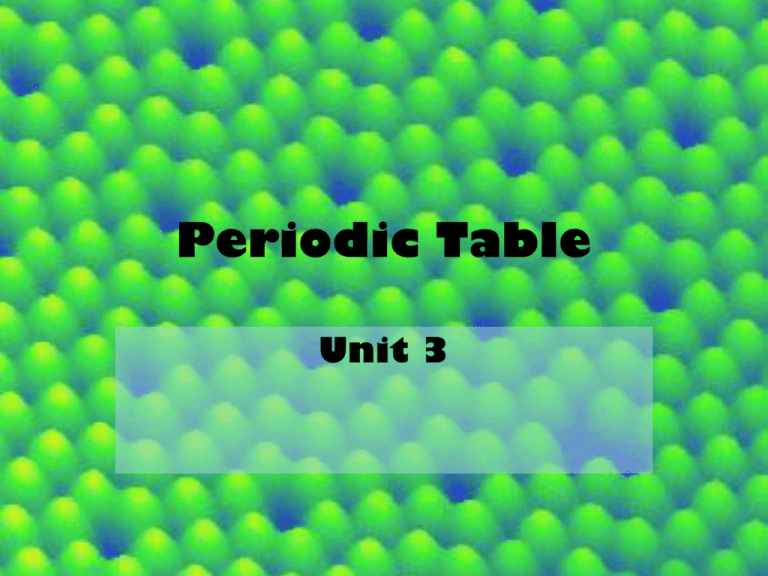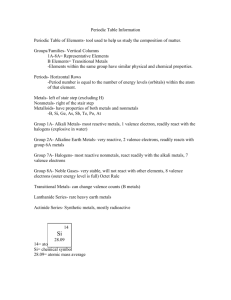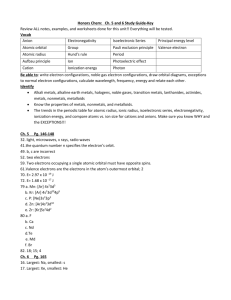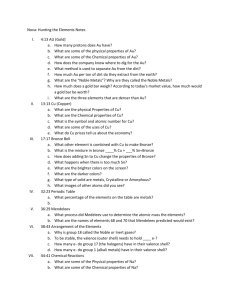Period Table Notes Unit 3
advertisement

Periodic Table Unit 3 Vocabulary Atomic Number Atomic Mass Atomic Symbol Valence electron Orbital Electron Shell Energy Level Valence shell Atomic Number -reflects the # of protons in the nucleus and electrons in the electron cloud of a balanced atom of that element. ATOMIC NUMBER = # OF PROTONS & ELECTRONS Atomic Number Atomic Mass -the sum of the protons and the average number of neutrons Atomic Mass # of Neutrons Atomic Mass (rounded to nearest whole number) minus # of protons AM - + p =N AM-P=N Example Atomic Symbol Putting it all together Atomic Number Element Symbol Atomic Mass Electron Orbitals aka Electron Shells aka Energy Levels -the location and the path around the nucleus where an electron can be found -the amount of energy carried by an electron in an atom Energy Level Maximum # of Electron’s each level can hold 8 e- 8 e- Nucleus 2 e- Nucleus Valence Shell -the outermost shell of an atom in its uncombined state -all atoms want their valence shells filled. Valence Electron • electrons located in the valence shell • # of valence e- will determine the reactivity of the atom. • The more Valence e’s the more stable and HAPPY (Noble Gases) • The less valence e’s the more reactive and EXPLOSIVE or UNHAPPY (Alkali Earth Metals) Dmitri Mendeleev • a Russian chemist and inventor • formulated the Periodic Law • created a version of the periodic table of elements • predict the properties of elements yet to be discovered Periods • A row of elements in the periodic table whose elements change gradually and predictably. – 7 periods – Period # = # of shells •Period 1 = 1 shell •Period 2 = 2 shells •Period 3 = 3 shells •Etc, etc Periods Groups (Families) • Columns in the Periodic Table that contain elements that have similar physical or chemical properties. – 18 groups – Elements have same # of valence e•Ex. Group13 has 3 valence e- Groups Metals • An element that has luster, is malleable, ductile, and is a good conductor of heat and electricity • Most are solids – Some are liquids (Mercury and Neptunium) • 91 metals Nonmetals -Gases or brittle solids -Poor conductors -Only 17 nonmetals -include elements vital to life (P,C,O,I, N, S) Sulfur Chlorine Carbon Metalloids -an element that shares some properties with metals and some with nonmetals. -6 metalloids Silicon Color Your Period Table I. Label the periods. (1-7) II. Label the groups. (1-18) III. Color metals blue. IV. Color non-metals yellow. V. Color metalloids green. VI. Create a key to show what each color represents. Group 1(Alkali Metals) -Li, Na, K, Rb, Cs, Fr -1 valence e-very reactive metals (except Hnon-metal) Li Na Sodium Potassium Lithium Rubidium Cesium Group 2 (Alkaline Earth Metals) -Be, Mg, Ca, Sr, Ba, Ra - 2 valence e-very reactive metals (less reactive than group 1) Mg Be Magnesium Calcium Barium Radium Beryllium Strontium Group 13 (The Boron Family) • B, Al, Ga, In, Tl • 3 valence e• All metal except B (metalloid) B AL Group 14 (The Carbon Family) • • • • • C, Si, Ge, Sn, Pb 4 valence eNonmetals: C Metalloids: Si, Ge Metals: Sn, Pb C Si Group 15 (The Nitrogen Family) • • • • • N, P, As, Sb, Bi 5 valence enonmetals: N, P Metalloids: As, Sb Metal: Bi P N Group 16 (The Oxygen FAMILY) -O, S, Se, Te, Po -6 valence e-nonmetals: O, S, Se -Metalloids: Te, Po S Group 17 (The Halogen/Halides Family) • F, Cl, Br, I, At • 7 valence e• All nonmetal except At (metalloid) • “salt-formers” F Cl Bromine Fluorine Chlorine Iodine Group 18 (The Noble Gases) • He, Ne, Ar, Kr, Xe, Rn • Full Valence shells=Stable • Rarely combine with other elements He Transition Elements • Groups 3-12 • All metals • Include the Inner Transition Elements – Lanthanide Series – Actinide Series Halogens Alkali Metals Alkaline Earth Metals Noble Gases Transition Elements Inner Transition Elements






